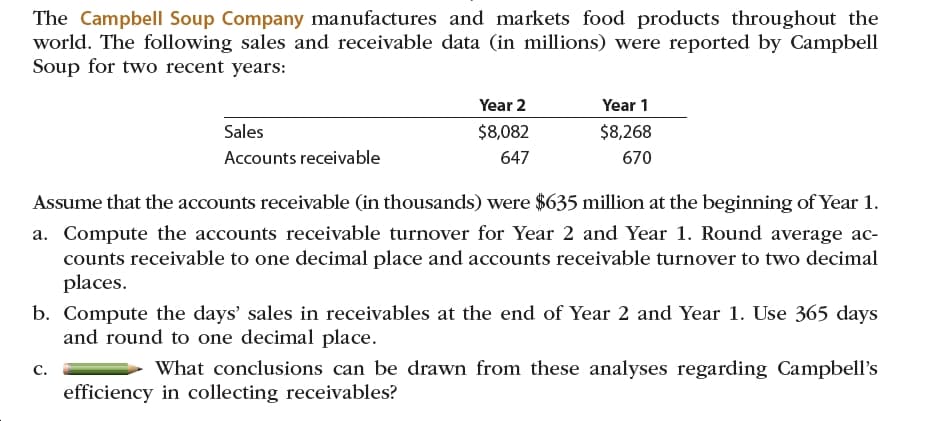The Campbell Soup Company manufactures and markets food products throughout the world. The following sales and receivable data (in millions) were reported by Campbell Soup for two recent years: Year 2 Year 1 $8,082 $8,268 Sales 670 Accounts receivable 647 Assume that the accounts receivable (in thousands) were $635 million at the beginning of Year 1. a. Compute the accounts receivable turnover for Year 2 and Year 1. Round average ac- counts receivable to one decimal place and accounts receivable turnover to two decimal places. b. Compute the days' sales in receivables at the end of Year 2 and Year 1. Use 365 days and round to one decimal place. What conclusions can be drawn from these analyses regarding Campbell's C. efficiency in collecting receivables?
The Campbell Soup Company manufactures and markets food products throughout the world. The following sales and receivable data (in millions) were reported by Campbell Soup for two recent years: Year 2 Year 1 $8,082 $8,268 Sales 670 Accounts receivable 647 Assume that the accounts receivable (in thousands) were $635 million at the beginning of Year 1. a. Compute the accounts receivable turnover for Year 2 and Year 1. Round average ac- counts receivable to one decimal place and accounts receivable turnover to two decimal places. b. Compute the days' sales in receivables at the end of Year 2 and Year 1. Use 365 days and round to one decimal place. What conclusions can be drawn from these analyses regarding Campbell's C. efficiency in collecting receivables?
Financial Accounting
14th Edition
ISBN:9781305088436
Author:Carl Warren, Jim Reeve, Jonathan Duchac
Publisher:Carl Warren, Jim Reeve, Jonathan Duchac
Chapter9: Receivables
Section: Chapter Questions
Problem 27E
Related questions
Question

Transcribed Image Text:The Campbell Soup Company manufactures and markets food products throughout the
world. The following sales and receivable data (in millions) were reported by Campbell
Soup for two recent years:
Year 2
Year 1
$8,082
$8,268
Sales
670
Accounts receivable
647
Assume that the accounts receivable (in thousands) were $635 million at the beginning of Year 1.
a. Compute the accounts receivable turnover for Year 2 and Year 1. Round average ac-
counts receivable to one decimal place and accounts receivable turnover to two decimal
places.
b. Compute the days' sales in receivables at the end of Year 2 and Year 1. Use 365 days
and round to one decimal place.
What conclusions can be drawn from these analyses regarding Campbell's
C.
efficiency in collecting receivables?
Expert Solution
Trending now
This is a popular solution!
Step by step
Solved in 10 steps with 4 images

Recommended textbooks for you

Financial Accounting
Accounting
ISBN:
9781305088436
Author:
Carl Warren, Jim Reeve, Jonathan Duchac
Publisher:
Cengage Learning

Financial Accounting
Accounting
ISBN:
9781337272124
Author:
Carl Warren, James M. Reeve, Jonathan Duchac
Publisher:
Cengage Learning

Principles of Accounting Volume 1
Accounting
ISBN:
9781947172685
Author:
OpenStax
Publisher:
OpenStax College

Financial Accounting
Accounting
ISBN:
9781305088436
Author:
Carl Warren, Jim Reeve, Jonathan Duchac
Publisher:
Cengage Learning

Financial Accounting
Accounting
ISBN:
9781337272124
Author:
Carl Warren, James M. Reeve, Jonathan Duchac
Publisher:
Cengage Learning

Principles of Accounting Volume 1
Accounting
ISBN:
9781947172685
Author:
OpenStax
Publisher:
OpenStax College

Managerial Accounting: The Cornerstone of Busines…
Accounting
ISBN:
9781337115773
Author:
Maryanne M. Mowen, Don R. Hansen, Dan L. Heitger
Publisher:
Cengage Learning

Financial Accounting: The Impact on Decision Make…
Accounting
ISBN:
9781305654174
Author:
Gary A. Porter, Curtis L. Norton
Publisher:
Cengage Learning

College Accounting, Chapters 1-27
Accounting
ISBN:
9781337794756
Author:
HEINTZ, James A.
Publisher:
Cengage Learning,